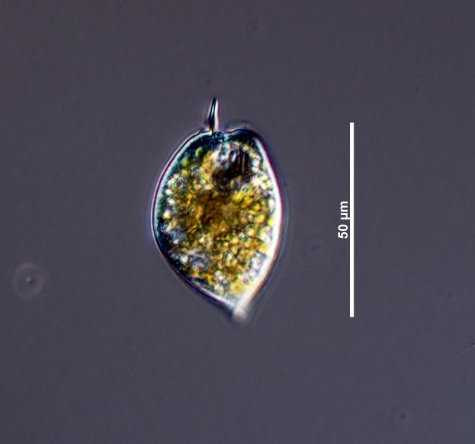



|
Synonym(s)
Prorocentrum schilleri Bohrn 1933
Prorocentrum levantinoides Bursa 1959
Prorocentrum pacificum Wood 1963
(Smithsonian 2011, Guiry and Guiry 2011)
Classification
(Guiry and Guiry 2011)
Lifestyle
Binary fission
A form of asexual reproduction where one cell divides into two identical cells. All prokaryotes and some eukaryotes reproduce in this manner. Compare with mitosis, where the nucleus must also divide, adding an extra step to the process.
binary fission (SAHFOS 2012).Description
Anterior
The front. The part of the cell in the direction of movement. Opposite of posterior (HPP 2003).
anteriorly and pointed ClosePosterior
The back end of a cell. Opposite of anterior.
posteriorly (Smithsonian 2011, SAHFOS 2011). There is a well-developed, short and winged CloseSpine
In some diatoms, "closed or solid structures projecting from the cell wall;" in dinoflagellates, solid projections that usually taper to a point.
spine originating from the anterior of the cell (Smithsonian 2011, Kraberg et al. 2010). Small pores originate from the cell CloseMargin
The outline or border that defines the shape of an organism or cell.
margins forming a unique pattern that runs towards the centre of the cell (Kraberg et al. 2010). The cell also has large pores posteriorly (Smithsonian 2011). Pores are most easily seen in CloseSEM
(scanning electron microscope) A microscope which applies "a focused beam of high-energy electrons to generate a variety of signals at the surface of solid specimens" (NSF 2011).
SEM. Prorocentrum micans has a large kidney-shaped CloseNucleus
(plural: nuclei) In eukaryotic cells, a membrane-bound organelle that contains the cell's genetic information; the nucleus controls the activities of the cell by controlling gene expression.
nucleus and two CloseVacuole
A membrane-bound organelle found in some protists, containing a water solution of organic and inorganic molecules (including enzymes). In some cases, vacuoles may contain engulfed solids (Falkowski et al. 2004).
vacuoles at the posterior (Dodge 1982).Measurements
Width: 20 - 50 μm
(Smithsonian 2011)
Similar species
Harmful effects
Habitat
Distribution
This species is Close
Cosmopolitan
Widely distributed; occurring in many parts in the world.
cosmopolitan in cold temperate to tropical waters (Horner 2002). It has been observed in North Sea, Atlantic and Pacific Oceans and the Mediterranean (Kraberg et al. 2010).Prorocentrum micans blooms in late summer to autumn (Horner 2002).
Growth conditions
Environmental Ranges
Temperature range (°C): 2.063 - 26.120
Nitrate (μmol L-1): 0.350 - 24.140
Salinity: 31.144 - 37.163
Oxygen (mL L-1): 4.709 - 7.510
Phosphate (μmol L-1): 0.083 - 1.585
Close
Silicic acid
A general term to describe chemical compounds containing silicon, oxygen and hydrogen with a general formula of [SiOx(OH)4-2x]n. Diatoms polymerize silicic acid into biogenic silica to form their frustules (Azam and Chisholm 1976).
Silicate (μmol L-1): 0.754 - 19.032(EOL 2011)
Bloom characteristics
References
Dodge, J. D. 1982. Marine Dinoflagellates of the British Isles. Her Majesty's Stationery Office, London, UK. 303.
Encyclopedia of Life (EOL). 2011. Prorocentrum micans Ehrenberg 1883. http://eol.org/pages/901667/details. Accessed 26 Dec 2011.
Guiry, M. D. and Guiry, G. M. 2011. Prorocentrum micans Ehrenberg 1833. http://www.marinespecies.org/aphia.php?p=taxdetails&id=110303. Accessed 27 Dec 2011.
Horner, R. A. 2002. A Taxonomic Guide To Some Common Phytoplankton. Biopress Limited, Dorset Press, Dorchester, UK. 200.
Kraberg, A., Baumann, M. and Durselen, C. D. 2010. Coastal Phytoplankton Photo Guide for Northern European Seas. Verlag Dr. Friedrich Pfeil, Munchen, Germany. 203.
Red-Tide. 2011. Prorocentrum micans Ehrenberg 1833. http://www.red-tide.org/new_site/pmin.htm. Accessed 27 Dec 2011.
Sir Alister Hardy Foundation for Ocean Science (SAHFOS) 2011. Prorocentrum micans Ehrenberg 1833. http://www.sahfos.ac.uk/taxonomy/phytoplankton/dinoflagellates/prorocentrum-micans-.aspx. Accessed 28 Dec 2011.
Smithsonian Institution. 2011. Prorocentrum micans Ehrenberg 1833. http://botany.si.edu/references/dinoflag/Taxa/Pmicans.htm. Accessed 28 Dec 2011.
Steidinger, K. A. and Tangen, K. 1997. Dinoflagellates. In: Tomas, C.R. (ed.) Identifying marine Phytoplankton. Academic Press, Inc., San Diego. 531.
